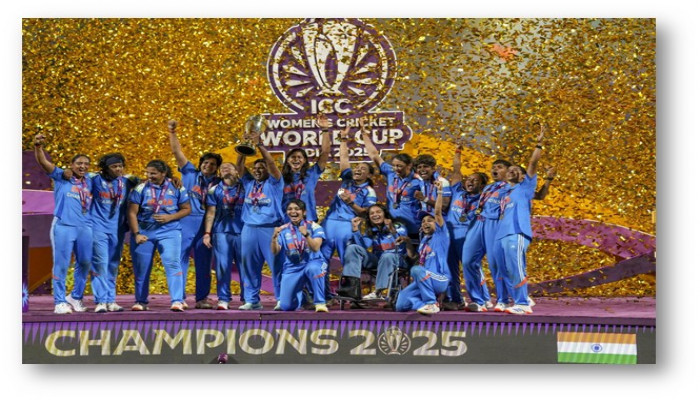Breaking Boundaries: Indian Women Conquer the Cricket World
- In LifeStyle & Sports
- 12:49 PM, Nov 04, 2025
- Shalini Venuturupalli
“Champions keep playing until they get it right.” — Billie Jean King
The wait is finally over. The Indian women’s cricket team has done what generations before them only dreamed of — they have lifted their maiden ICC Women’s World Cup Trophy. This victory is not just about the eleven players who took the field; it’s a moment of pride for every woman who has ever dared to dream with a bat in hand and belief in her heart.
The triumph stands as a testament to years of perseverance, grit and passion. From dusty, domestic pitches to the grandest stage of world cricket, this journey has been fuelled by the tireless effort of those who paved the path long before the spotlight arrived. For millions of fans across the country, this is more than just a cricketing achievement – it is an inspiring symbol of India’s growing sporting spirit and women’s empowerment.
The campaign began on a bright note. India breezed past Sri Lanka and Pakistan, looking every bit like a team on a mission. But as the tournament progressed, cricket reminded them that no path to greatness is without hurdles. Consecutive losses to South Africa, Australia and England left their campaign hanging by a thread. Yet, in true Indian spirit, the team refused to give up.
The turning point came against New Zealand, when Smriti Mandhana and rising star Pratika Rawal produced stellar performances to guide India to a much-needed win and secure a semi-final berth. But destiny had one more test in store. During a rain-hit match against Bangladesh, the in-form Rawal sustained an injury that ruled her out of the remainder of the tournament. She was replaced by the dynamic Shefali Verma, whose inclusion would later prove crucial.
The semi-final line-up looked daunting. India was to face Australia, the same side that had handed them a crushing defeat earlier in the group stage. The tension was palpable, the expectations immense. But champions thrive under pressure – and on that night, India turned adversity into artistry.
Australia posted a formidable 338, thanks to some explosive batting. At one point, they looked set for 350-plus, but the Indian bowlers held their nerve to keep the target within reach. It was still a mountain to climb – no team had ever chased that score in Women’s World Cup history.
When both openers fell early, the challenge looked even steeper. But what followed was a partnership that will be remembered for years. Jemimah Rodrigues, promoted to no 3, was joined by skipper Harmanpreet Kaur in the middle. The duo weathered the storm and then counterattacked, stitching together a magnificent 167-run stand for the third wicket. Jemimah, calm yet commanding, notched up her maiden World Cup century.
As the equation tightened, Richa Ghosh and Amanjot Kaur delivered the final flourish. Against all odds, India crossed the line with a few balls to spare, scripting the highest successful chase in Women’s World Cup history and etching their names into cricketing folklore.
With Australia out of the way, India now faced an equally confident South Africa, which had dismantled England in their semifinal by 125 runs. One team had successfully defended a 300-plus total; the other had chased one. A blockbuster final was on the cards.
Inserted to bat first, India got off to a flying start. The openers stitched a 104-run stand for the opening wicket, setting a solid platform. Smriti fell soon after, while Jemimah and Harmanpreet got starts but couldn’t capitalise further. Shafali held firm with a fluent 87 keeping the scoreboard ticking. Deepti Sharma’s composed half-century and valuable cameos from Amanjot and Richa powered India to 298 – the second-highest total in Women’s World Cup history.
At the halfway mark, the question loomed large: was 298 enough against a side that had not lost a single match while chasing? The Indian supporters were optimistic but anxious.
The chase began with South Africa’s captain, Laura Wolvaardt, leading from the front. Her effortless strokeplay brought her a fine century, and for a while, she seemed unstoppable. But the Indian bowlers kept striking at crucial intervals, never allowing a partnership to settle.
The turning point came when Wolvaardt mistimed a lofted drive and was caught at long-off. The Indian players erupted — the door had opened, and they stormed through it. South Africa’s middle and lower order collapsed under pressure, and moments later, India completed a famous win.
The celebrations that followed were scenes for the ages — teammates in tears, tricolours waving in the stands, and the echoes of a billion hearts beating in unison. The Indian women had done it. They are world champions.
This triumph is not just a sporting milestone – it is a cultural moment. It signifies a shift in how women’s cricket is perceived, celebrated and supported in India. Young girls across the nation, watching with wide eyes and proud hearts, now know that the dream of playing for India is not distant – It’s possible.
From Mithali Raj’s pioneering days to Harmanpreet Kaur’s era of dominance, Indian women’s cricket has come a long way. The World Cup win is both a culmination and a new beginning — one that promises a brighter, more inclusive future for Indian sport.
As the captain lifted the trophy under the floodlights, the message was clear – Indian women’s cricket has arrived and is here to stay.
For every young girl who picks up a bat today, this victory whispers a promise: The World is yours to conquer.
Disclaimer: The opinions expressed within this article are the personal opinions of the author. MyIndMakers is not responsible for the accuracy, completeness, suitability, or validity of any information on this article. All information is provided on an as-is basis. The information, facts or opinions appearing in the article do not reflect the views of MyindMakers and it does not assume any responsibility or liability for the same.







Comments